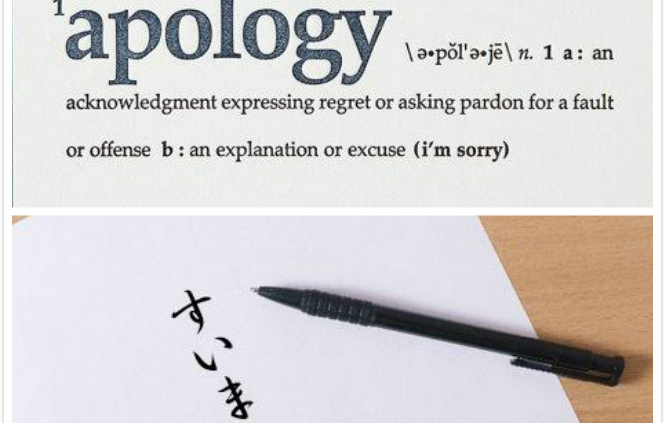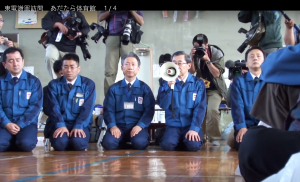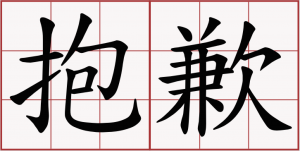Cross-Cultural Study of Corporate Apologies – GUEST BLOG BY Stella Danqing Zhao
Introduction by Iris Wenting Xue:
This is my second in a series of guest blogs featuring my recently-graduated capstone (thesis) advisees in New York University’s Master’s in Public Relations and Corporate Communication.
I myself was a guest-blogger when I graduated two years ago from the program. (See A 10-C Model for Apologies here.) And it is my great honor to become a Capstone advisor and contribute to the program.
In her capstone, Stella Zhao analyzed corporate apologies in terms of wording, tone and body language. She compared different apology styles in the U.S., China, and Japan and came up with customized recommendations. As she notes, apology is not only about communication but also about anthropology. You can read the entire capstone here.
…………………..
Through the Looking Glass:
A Cross-cultural Study on Proper Usages of Verbal and Nonverbal Elements in Corporate Apology Speeches – Guest Blog By Stella Danqing Zhao
My thesis is a study on different apology styles regarding wording, tone, and body language in the U.S., China, and Japan. The wording part mainly focused on IFIDs of each country, which means “Illocutionary Force Indicating Device”, also known in this case as the key apologetic words. The body language part focused on the eye contact, facial expression, gesture, posture, and also a particular way of apologizing – bowing.
The study contains two parts – study and survey. In the case study part, nine cases, three from each country, are analyzed to find the common apologetic words, tone, and body languages:
U.S.
- Domino’s Pizza:
- General Motors:
- Blackberry:
China
- 2015 Shenzhen Landslide:
- Mindy Quah:
- Sixth Naphtha Cracking Plant:
Japan
- Rikuentai Bus Company:
- Tokyo Electric Power Company:
In the survey part, a survey was distributed and assembled using the survey software Qualtrics. Participants were first asked to answer a few questions on corporate apologies to see their general perceptions regarding wording, tone, and body language. After this part, they were shown two corporate public apology speech videos – one from Volkswagen, the other from Toshiba. To exclude the influence of participant’s knowledge of certain language, they were asked to focus only on the nonverbal part and answered a few questions regarding on the tone and the body langue of the two speakers.
- Volkswagen:
- Toshiba:
Conclusion
Based on the case studies and the survey, several similarities and differences were found between the perspectives of the audiences from those three countries. Therefore, we can have some recommendations on different apology styles in each country.
U.S.
In the U.S., the most common IFIDs are “sorry” and “apologize”. According to the survey, people believe that the word “apologize” is more effective than the word “sorry”, but both of them can be used based on different situation. When using apologetic words, adverbs such as “sincerely” can be used to strengthen the tone. Honorific words are not extremely necessary and the speech can be informal to some degree, but it should still be written clearly and express regrets.
A consensus between the three countries is that the tone of an apology speech should be regretful, humble, and empathetic. However, in the U.S., people can accept a more firm, positive, and confident apology. It’s important to show your audience that you have the determination to fix the problem.
As to the body language, it’s important to make direct eye contact in the U.S. Avoiding direct eye contact can be seen as hiding and dishonest. The facial expression should be serious, and proper gestures can be applied. The posture should be formal but with natural movements instead of standing stiffly. Bowing is not recommended in the U.S. because it may be seen as an overreaction.
China.
In China the common IFID is the derivatives of the word “qian (歉)” [In English: apology] such as “bao qian (抱歉)” [In English: apologize] and “dao qian (道歉)” [In English: apology/apologize] . “dui bu qi (对不起)” [In English: I am sorry] is also a common apologetic word but it’s less used in a formal corporate apology. Adverbs such as “cheng ken (诚恳)” [In English: sincerely] and “fei chang (非常)” [In English: very] can be used to show sincerity. One should also address the audiences with “nin (您)” [In English: you, but in a very respectful way, like “Your Majesty” rather than “Hey, you”], which is the honorific form of “you” in Chinese. The speech should be written in a formal style.
Besides being regretful, humble and empathetic, the tone of the apology speech should let people feel that you are somehow ashamed for the wrongdoing, which shows that you realized what you did was improper. It should also be firm without hesitation.
In China, direct eye contact is also welcomed. People can accept having a modest smile on their face, which means the facial expression doesn’t need to be blank or stiff. Proper gestures can be applied, and the posture should be as formal as possible. Although bowing is not required in apology speeches in China, it is recommended to show more sincerity.
Japan.
In Japan, there are strict requirements for the choice of apologetic words. Using informal IFIDs such as “sumimasen(すみません)” [In English: Excuse me] and “gomen nasai(ごめんなさい)” [In English: apologize in daily setting] can be seen as a mistake. IFIDs such as “moushiwage gozaimasen (申し訳ございません)” [In English: apologize in professional setting] and “owabi shimasu (お詫びします)” [In English: apologize in professional setting] are recommended. One can use multiple apologetic words in one apology to make it stronger. Using adverbs such as “fukaku (深く)” [In English: deeply] and “hontoni (本当に)” [In English: truly] are also a good way to show sincerity. Honorific form of the words is required in a formal apology.
In Japan, the tone of the apology speech should be more “negative”, meaning it should be more sad, regretted other than positive and confident. It’s better to show you remorse for bringing other people trouble.
Direct eye contact is not recommended when apologizing to Japanese people. Lowering the head can show your regrets and humble. A smile is strongly prohibited. Although in the survey the respondents didn’t disagree with using gestures, they are seldom found in previous apology speeches. Usually, Japanese people stand in a very formal posture with their hands beside their body. Bowing is required and can be applied multiple times according to different situations.
| U.S. | China | Japan | ||
| Wording | IFID | “Apologize”/”Sorry” | Derivatives of “qian” (歉) |
“moushiwage gozaimasen” (申し訳ございません) “owabi shimasu” (お詫びします) |
| Adverb | Sincerely | “fei chang” (非常)
“cheng ken” (诚恳) |
“hukaku” (深く) “hontoni” (本当に) |
|
|
Honorific Form |
✖ | ✔ | ✔✔ | |
| Tone |
Regret Humble Empathetic |
Positive
Confident Firm |
Firm
Ashamed |
Sad Ashamed |
| Body Language | Eye contact | ✔✔ | ✔ | ✖ |
| Smile | ✖ | ✔ | ✖ | |
| Gesture | Apply properly | |||
| Posture | Somewhat natural | Formal | Formal | |
| Bow | ✖ | ✔ | ✔✔ | |
The table above briefly summarizes how wording, tone, and body language shape public perceptions of corporate apologies, and how apology style differs in U.S., China and Japan. Reflecting on a better understanding of how stakeholders think and feel can help a leader, and those who advise the leader, to more likely craft an apology that will work.









Leave a Reply
Want to join the discussion?Feel free to contribute!